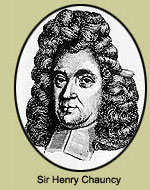|
 Born 12 April 1632 at Yardley Bury, Yardley, Hertfordshire, Henry Chauncy first attended school at Yardley vicarage. At the age of nine he went to Stevenage Grammar school, where he stayed for five years, and spent just one year at Bishop's Stortford Grammar school under headmaster Thomas Leigh. Aged fifteen he went to Gonville and Caius College, Cambridge, but left without taking a degree. Regardless of any academic qualifications he was admitted to the Middle Temple, London, in 1650, and was called to the bar in 1656. Born 12 April 1632 at Yardley Bury, Yardley, Hertfordshire, Henry Chauncy first attended school at Yardley vicarage. At the age of nine he went to Stevenage Grammar school, where he stayed for five years, and spent just one year at Bishop's Stortford Grammar school under headmaster Thomas Leigh. Aged fifteen he went to Gonville and Caius College, Cambridge, but left without taking a degree. Regardless of any academic qualifications he was admitted to the Middle Temple, London, in 1650, and was called to the bar in 1656.
Chauncy went on to hold a number of high positions at law in Hertfordshire, founded Hertford's Blue Coat School, and was knighted by Charles II in 1681. That same year he inherited his father's estate, which eventually gave him the opportunity and financial resources to give up the legal profession and compile *The Historical Antiquities of Hertfordshire.
It took him fourteen years to research and a further five years in the press, but it was finally published as a single large volume in 1700, the 500 copies dedicated to its principle sponsor the third earl of Bridgewater. The book was not, however, completed to his original design. Escalating costs and a private legal dispute prevented him from using further material he had gathered, his original intention being to publish it as an appendix and give to readers free of charge. As it turned out, the additional material was freely drawn upon by Nathaniel Salmon for his History of Hertfordshire, published in 1728.
Chauncy is widely credited as Hertfordshire’s greatest historian, and his Antiquities is regarded as the rockbed for all histories of Hertfordshire written before the 20th century. It has subsequently been drawn upon not only by Nathaniel Salmon, but also by 19th century historians, Robert Clutterbuck and J.E. Cussans.
Chauncy gave the following account of Bishop's Stortford:
‘This town is built in the form of a cross, having four streets pointing east, west, north and south; and is situated in an wholesome and sweet air, on dry soil, on the east side of a hill facing the rising sun; and extends from the upper part of a hill to the River Stort, which encompasseth the castle and divides the town from a street called Hockerill, that extends to the upper part of the opposite hill, and upon the east side of the river was a castle, and St Osyth’s Well, a spring held good for the eyes’.
He also described the school as ‘An excellent nursery that supplied both Universities with a great number of gentlemen who proved eminent in divinity, law and physics, and some matters of State’.
Henry Chauncy married three times and fathered nine children. He maintained his house at Yardley Bury, but also lived at Lombard House, Hertford, where he is said to have written much of Antiquities. He died at Yardley Bury at the end of April 1719 and was buried in the parish church.
*Only 500 copies of the first edition were printed in 1700. A second edition, in two volumes with folding map and 45 engravings, was produced in 1826 by John Morse Mullinger in his print shop at No 18 North Street, Bishop's Stortford. This version was reprinted in 1975 but is now out of print.
*Additional information taken from the Oxford Dictionary of National Biography
|
|

